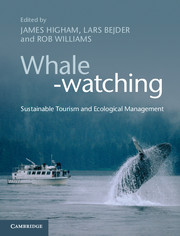Book contents
- Frontmatter
- Dedication
- Contents
- Acknowledgements
- List of contributors
- List of abbreviations
- 1 Tourism, cetaceans and sustainable development
- Part I The historical and contemporary contexts
- Part II Human dimensions of whale-watching
- 7 The whaling versus whale-watching debate
- 8 Iceland and the resumption of whaling
- 9 Green messengers or nature's spectacle
- 10 Whale-watching
- 11 What's in it for the whales?
- 12 Integrating traditional ecological knowledge and community engagement in marine mammal protected areas
- Part III Ecological dimensions of whale-watching
- Part IV Sustainable management: insights and issues
- Index
- Plate Section
- References
9 - Green messengers or nature's spectacle
Understanding visitor experiences of wild cetacean tours
from Part II - Human dimensions of whale-watching
Published online by Cambridge University Press: 05 April 2014
- Frontmatter
- Dedication
- Contents
- Acknowledgements
- List of contributors
- List of abbreviations
- 1 Tourism, cetaceans and sustainable development
- Part I The historical and contemporary contexts
- Part II Human dimensions of whale-watching
- 7 The whaling versus whale-watching debate
- 8 Iceland and the resumption of whaling
- 9 Green messengers or nature's spectacle
- 10 Whale-watching
- 11 What's in it for the whales?
- 12 Integrating traditional ecological knowledge and community engagement in marine mammal protected areas
- Part III Ecological dimensions of whale-watching
- Part IV Sustainable management: insights and issues
- Index
- Plate Section
- References
Summary
Introduction
In western countries, whales and dolphins are iconic wildlife species and have been a key focus of marine conservation efforts since the 1970s. Social values based on conservation influence the type of benefits now sought from marine wildlife interactions, such as the trend towards non-consumptive viewing of wild cetaceans rather than killing whales or dolphins (Frohoff & Packard, 1995; Muloin, 1998; Bulbeck, 1999; Kellert, 1999; Hoyt, 2003; Parsons et al., 2003; Higham & Lusseau, 2004; Corkeron, 2006; Neves, 2010; Brakes & Simmons, 2011), or seeing wild instead of captive dolphins (Hughes, 2001; Bulbeck, 2005). These new environmental and amenity values of cetaceans as ‘charismatic mega-fauna’ have underpinned the rapid worldwide growth in whale- and dolphin-watching as a marine tourism activity (Hoyt, 2001; Orams, 2005; Cisneros-Montemayor et al., 2010). In 2008, over 13 million people went on whale-watching tours in 119 countries, generating income of US $2 billion in coastal economies (IFAW, 2009). The economic and conservation benefits of cetacean tours are supported by organizations such as the Pacific Whale Foundation, Whale and Dolphin Conservation, and Whales Alive.
Whale-watching is defined as ‘the watching of any cetacean in the wild, an activity which is almost invariably conducted from a platform (e.g. ship, cliff or aeroplane)’ (Warburton, 1999: 12) and as ‘any commercial enterprise which provides for the public to see cetaceans in their natural habitat’ (Warburton et al., 2001: 5). Swimming with humpback whales (Megaptera novaeangliae) in Tonga (Orams, 2001; Kessler & Harcourt, 2010), dwarf minke whales (Balaenoptera acutorostrata subspecies) in Australia (Birtles et al., 2002; Valentine et al., 2004), and wild dolphins (Amante-Helweg, 1996; Orams, 1997a; Hughes, 2001; Luck, 2003; Samuels et al., 2003; Blewitt, 2008; Zeppel, 2009; Draheim et al., 2010) are popular activities in selected locations where this is legally permitted. As a result, there is a growing body of research about visitor experiences of wild cetaceans.
- Type
- Chapter
- Information
- Whale-watchingSustainable Tourism and Ecological Management, pp. 110 - 127Publisher: Cambridge University PressPrint publication year: 2014
References
- 5
- Cited by



